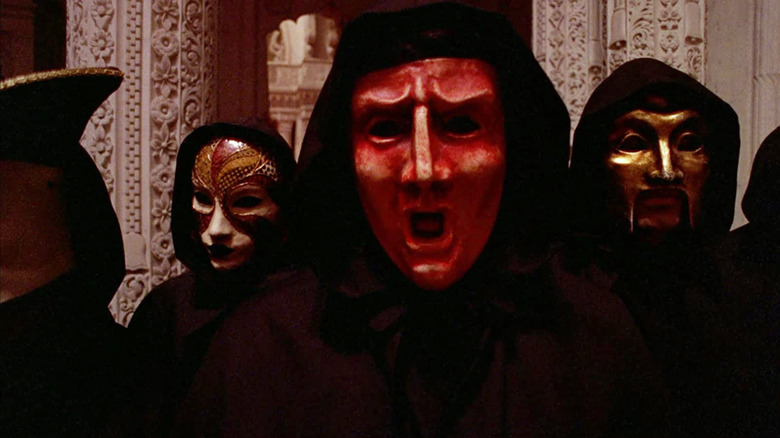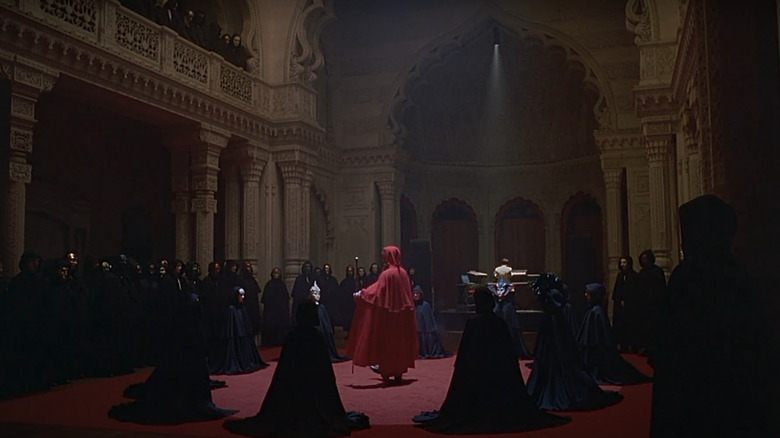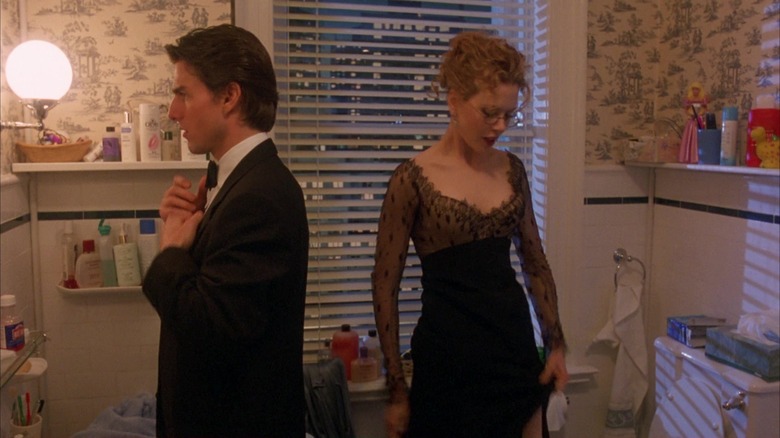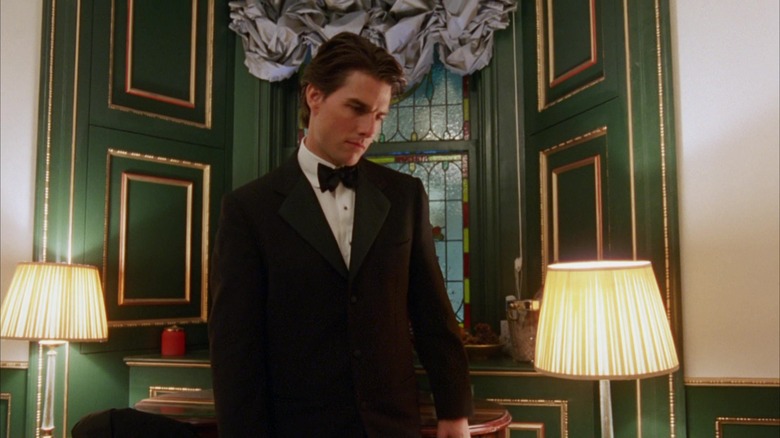Research Was Key When It Came To Creating Eyes Wide Shut's Most Famous Scene
There was a fragile consensus about "Eyes Wide Shut" when it debuted back in 1999: that it was a bit of a letdown. Audiences had expected to see married co-stars Tom Cruise and Nicole Kidman play out erotic fantasies and were disappointed to experience Stanley Kubrick's oneiric odyssey instead. But while the effect of that disappointment still lingers, as with all Kubrick films, time has seen "Eyes Wide Shut" gain more respect as a multi-layered exploration of sexual desire and naivety.
The film defies precise definition with its mix of dark humor, drama, and erotic imagery. It's based on Arthur Schnitzler's 1926 novella "Traumnovelle" ("Dream Story"), shifting the events of the book from early 20th-century Vienna to late-'90s New York City. Tom Cruise plays Dr. Bill Harford whose wife, Alice (Nicole Kidman), sends him reeling into the New York night after revealing she'd considered having an affair. The resulting narrative subverts Cruise's established reputation as a handsome leading man by depicting him bumbling around Kubrick's fabricated New York (built on sound stages at England's Pinewood Studios), driven by psychosexual urges that never quite propel him to actually cheat on his wife — even when he stumbles upon an orgy.
The centerpiece of "Eyes Wide Shut," the orgy scene has become cultural shorthand for ominous secret societies and their supposed depraved activities. Dr. Bill infiltrates a ritual attended by a cabal of what's suggested to be New York's elite, all obscured by masks from Italy's Commedia dell'arte tradition. A host of young women are on-hand and the resulting orgy is less erotic than it is unsettling, ultimately culminating in a young woman sacrificing her life to protect Dr. Bill. And as you might expect with Kubrick, the whole thing took months of rehearsal and improvisation to bring to fruition.
Kubrick's research project
Infamous for his perfectionist approach, Stanley Kubrick took his exhausting methods to a new extreme with "Eyes Wide Shut," at one point allegedly making Tom Cruise perform 95 takes of walking through a doorway. But according to Vulture's oral history (published in 2019), the orgy scene was one of the most difficult scenes (if not the most difficult).
Choreographer Yolande Snaith worked with a team of women that had been hand-picked by longtime Kubrick assistant and actor Leon Vitali, who claimed the women were required to be, "Totally natural. No Botox, no breast enhancements." But even then, Kubrick seemed unsure of what he wanted from the choreography. Snaith said the director at least seemed settled on the idea of something "surreal and suggestive" rather than outright pornographic, but also treated months of rehearsals as "a sort of research period," providing feedback on Snaith's ideas. The process became so protracted, that, as Vitali explained:
"We were taking so long that sometimes the leases ran out on where we could rehearse. I was having trouble holding on to some of the girls I'd found because they had other obligations and jobs. And then we had to find some more because we realized we didn't have enough. It was all very Stanley."
"All very Stanley" sounds about right. The auteur famously often spent years researching and planning his films, only to show up on set and, as he put it, yield to the "reality of the final moment." That's why he would demand an ungodly number of retakes, pushing actors until something spontaneous occurred and defined the scene. In the case of "Eyes Wide Shut," the orgy scene was one protracted effort to find the "reality of the final moment," despite the voluminous research that went into it.
Years of research didn't help
Even going into planning the crucial scene, Stanley Kubrick seemed, at least to his crew, somewhat unsure. As first assistant director Brian Cook remembered it, he implored the filmmaker to bring in outside directors to help:
"I used to say to Stanley, 'We should get Adrian Lyne or Tony Scott to come and shoot this stuff for us. They know how to do this, Stanley. You don't!' [...] Stanley wasn't keen on doing it in many ways. It wasn't his stuff, to be honest with you."
According to Cook, the team had "years and years of research" to rely on but that didn't necessarily help bring the scene to fruition in a timely manner. Kubrick had sought advice from G. Legman, a friend of assistant Anthony Frewin, who provided information on secret societies and "sexual mores in Vienna at the time of Schnitzler." That took the form of illustrations depicting 19th century "secret-society rituals and the Black Mass." Meanwhile, artist Félicien Rops lent his expertise on "weird erotica" to the film.
All of this provided a solid foundation on which to construct Kubrick's secret society ritual/orgy. But it didn't help speed up the already sluggish production, with Cook recalling how the orgy scene "kept getting pushed back and back and back in the shoot." Aside from Kubrick applying his usual tactic of trying things multiple ways before yielding to the "reality of the final moment," Cook maintained that erotica simply "wasn't his stuff." Add to that the pressures of finding the right venue in which to film, and the orgy amounted to what might have been the trickiest part of an extremely complex shoot, even by Kubrick's standards.
'The sexual relations film'
The final orgy scene betrays none of these behind-the-scenes struggles. Its striking shots meld dark humor (Dr. Bill arrives in a yellow cab, while the attendees' black limos are parked proudly outside) with genuinely disturbing moments (the Commedia dell'arte-inspired masks are quietly horrific), all the while emphasizing just how out of his depth Dr. Bill is. Sure, Warner Bros. messed it up with their digitally-added bodies to obtain an 'R' rating, but the point stands.
The film revels in subversiveness throughout, whether it's subverting the Christmas setting with vivid depictions of sexuality, or subverting Tom Cruise's reputation as a handsome leading man by basically putting Dr. Bill through one long lesson in just how naive and uninformed he is. It's funny and carnivalesque, yet soberingly serious at the same time. That's never more obvious than during the orgy, and in that sense, despite the difficulty of bringing it to fruition, the scene fulfills its purpose as a clear distillation of the film's core themes and tone.
Much of the difficulty does seem to come down to Stanley Kubrick's lack of experience with such explicitly erotic material. As screenwriter Frederic Raphael told EW in 1999, "Like a lot of people of my generation, I think Stanley felt he missed the sexual revolution [...] It was a genre — the sexual relations film — he'd never attempted before." Having waited literally decades to adapt Schnitzler's novella, it's no wonder Kubrick was determined to spend the time getting things right, even if it was partly down to, like Dr. Bill, being a little out of his depth. It didn't culminate in the Cruise/Kidman (figurative) sex tape everyone was expecting, but it's thankfully become recognized for the fascinating, subversive exploration of jealousy, sexuality, and naivety (both Bill and Kubrick's) that it is.



